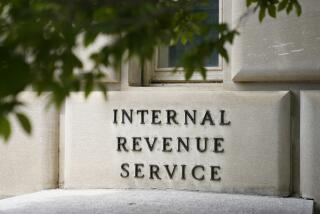Alterations to IRS Forms Aim to Simplify Returns
Tax season is officially half a year away, but already there’s some good news for those who are concerned about the complexity of filing a tax return.
The Internal Revenue Service is in the midst of its annual review of the nation’s tax schedules and has already proposed a few changes that should make paying taxes a little bit easier for millions of Americans.
People who earn between $50,000 and $100,000 annually, for example, no longer need to deal with the three-step calculation that was previously necessary to determine their tax.
Last year, if you were married filing jointly and earned $50,000, for example, you had to negotiate the Schedule Y-1. That asked you to subtract $34,000 from your income to come up with $16,000. Then multiply $16,000 by 28%. Your answer of $4,480 then had to be added to $5,100 to determine that the total tax owed was $9,580.
Starting with the 1992 return, all you’ll need to do is look up your tax on the expanded tax tables. The tables, which previously listed the tax for anyone earning up to $49,999, now provide pre-calculated tax information for anyone with earnings of $100,000 or less, the IRS says. This change alone should affect about 14 million taxpayers.
*
Meanwhile, those with a modest amount of income from a small business should know that the IRS has introduced a vastly simplified version of the Schedule C, which is required for those reporting a profit or loss from a sole proprietorship.
If the business has gross receipts of $25,000 or less and you’re claiming no more than $2,000 in business expenses, the agency says you can now fill out the Schedule C-EZ.
Like the 1040-EZ, this form is short and sweet, made up of only eight questions versus the 40 questions on the basic Schedule C. The IRS estimates that about 3 million taxpayers will be able to use this new short form.
There are a handful of other modest changes to tax schedules in the 1992 crop, added Jan Gribbon, an IRS spokeswoman in Los Angeles. If you’ve got a gain or loss from a one-time event, you may have to fill out a new form. There’s a new place to report fees paid to management companies that help rent out investment property. And there’s a bit of new wording here and there in a variety of forms.
Notably, too, there’s a new box on top of the Schedule 1040A, which is a computer code designed to allow these forms to be scanned electronically. The IRS now has a staff of typists who transfer information from paper returns into government computers. Optical scanning allows the information to be transferred electronically--without the typists. The main benefit of the process is that it saves time and cuts down on errors, said Gribbon.
The agency has been using optical scanning on 1040-EZ forms for the last two years. Since then, the IRS says it has reduced the amount of time it takes to process EZ refunds from six weeks to four.
Anyone who is interested in the specific changes made to the 1992 tax forms can get a look by going to a library that subscribes to any one of the various tax reporting services, such as Commerce Clearing House. Most business and law libraries, as well as many college libraries, are subscribers. Most tax accountants also have the new “proof” forms and may be willing to show them to their customers.
Why might you want to get an early look? For one thing, it gives you the opportunity to suggest changes. Each year at about this time, the IRS starts soliciting comments and suggestions about how to make its forms more readable and easier to complete.
Many of the changes made during the last few years have been the product of consumer and tax preparer suggestions, according to the IRS.
“What we are looking for is language that isn’t clear or that’s too lengthy,” Gribbon said.
*
Additionally, if something needs more explanation, if there’s a way to combine information in fewer lines, or if you can figure out a way to simplify a calculation, the IRS wants to hear from you, Gribbon added.
Those with comments and suggestions relating to the 1992 tax forms should send them to the Tax Form Committee Early Release Program, Internal Revenue Service, Room 5577, 1111 Constitution Ave. N.W., Washington, D.C. 20224.
Don’t bother complaining about tax rates, though. If you believe that you’re paying too much tax, complain to Congress, not the IRS. Congress makes the rules and sets the rates. The IRS just enforces the law.
More to Read
Inside the business of entertainment
The Wide Shot brings you news, analysis and insights on everything from streaming wars to production — and what it all means for the future.
You may occasionally receive promotional content from the Los Angeles Times.










